DEEP CONNECTIONS; DAUGHTER, FATHER, HOPKINS LANDING.

Don Hopkins and his dog Sally enjoying the serenity of sitting on the beach logs at Hopkins Landing. Donald and his brothers Charles and Philip grew up at the Landing which was founded by their Grandfather, George Henderson Hopkins. While life took the brothers to other places they all returned to spend some or all of their retirement years at the Landing. Don and his wife Joan lived many happy years at the Landing. They made wonderful friends and reconnected with family there. Don built himself a small studio behind the house and created a Japanese garden outside with a pond and bamboo water feature. He loved to garden as much as creating his art and was instrumental in starting the annual vegetable growing competition. He bequeathed a rather homely carved horn fish he had been given by the National Film Board at retirement to be used as a ‘grand’ trophy. The competition carries on today and the trophy is still being awarded.
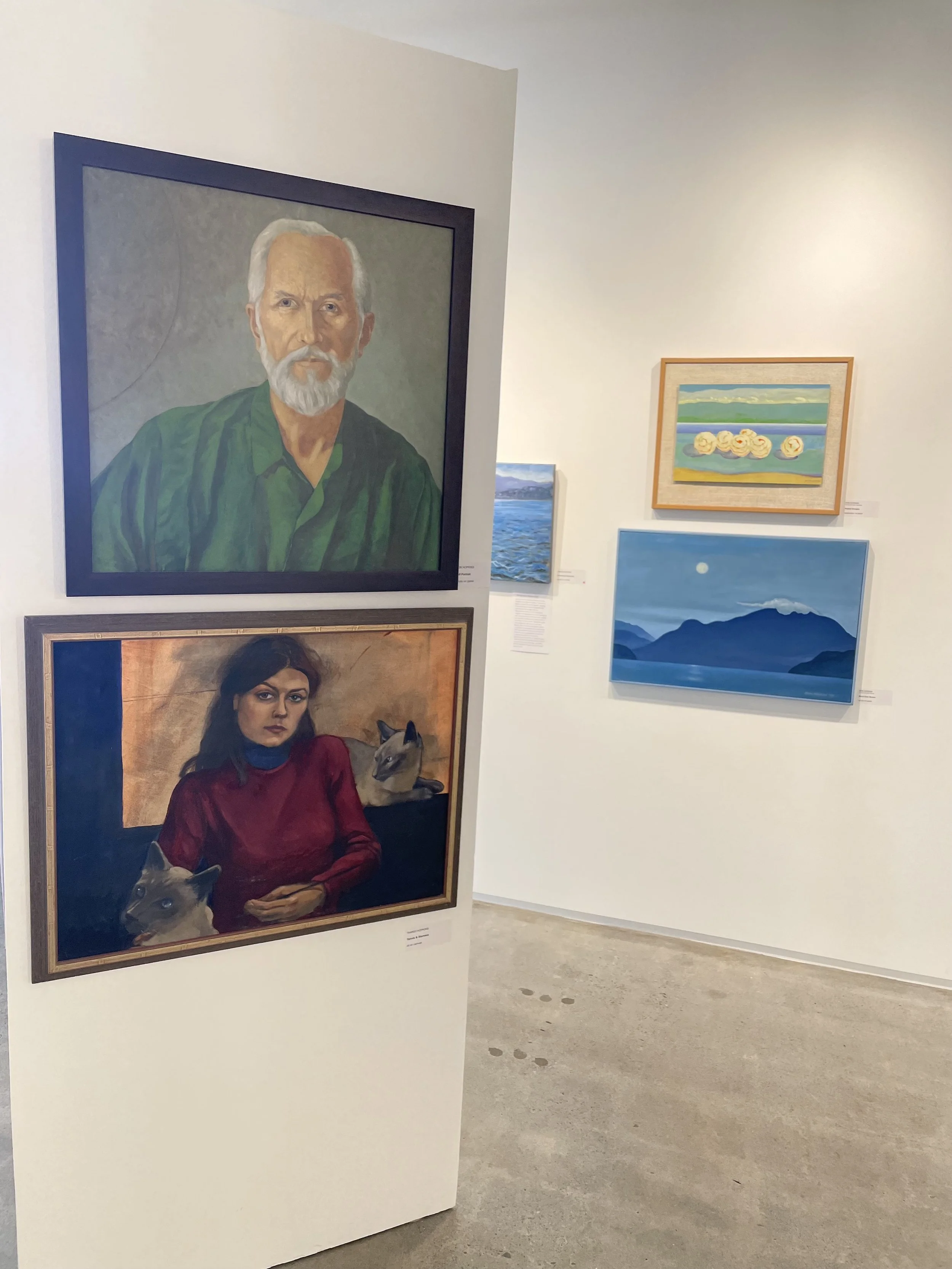

Union Steamships were the connection between communities on Howe Sound and the coast.

Don and Charlie Hopkins rowing off the shore of their home in Hopkins Landing. The brothers were two of the nine grandchildren of Isa and George H Hopkins who founded the Landing in 1907. In his retirement years, Don, my Dad, dreamt of building a boat but never realized that dream. He acquired a Davidson rowboat which he loved. It was a sturdy, practical boat about 10 feet long and relatively heavy. Dad made a simple two wheeled carrier but getting the boat from my parents front lawn over the logs on the beach to the water was no mean feat. He built an elaborate set of folding, hinged runners for the wheels that acted like a bending bridge up over the logs. I’m not sure they were a total success but they were quite the invention. Dad always seemed to be coming up with adaptations for things.

My father Donald, and his older brothers Charles and Philip.
“Uncle Charlie” Charles Hopkins was a tall lean drink of water (or gin) with a wonderful sense of humour. I will always hear his laugh in my mind. He was an accomplished lawyer and partner in a Vancouver Law Firm and mentored many up and coming young lawyers. Charlie met the love of his life while attending UBC. My Aunt Bev, a beautiful, gracious women, worked as the first child psychologist for the City of Vancouver. They settled in West Vancouver but had a local wood worker build a stunning log home on their Hopkins Landing property. They enjoyed many summers there playing golf and pushing logs off the beach at high tide. Uncle Charlie created many wood carvings (that creative streak in the brothers) while staying at his Landing cabin. He and my father snuck out one night after a few drinks and installed the routered Hopkins Landing sign that still remains above the ramp. I shudder to think of them wobbling on a ladder doing that! The sign is in bad repair as is the beloved wharf so I doubt it will last much longer. Especially with the recent safety warnings and closure of the wharf and needed repairs to be planned. Charles Stodart Hopkins Nov 17, 1925 - Oct 25 2019. Beverly Elizabeth (Hall) Hopkins Oct. 15, 1926 - April 29, 2016 I am very grateful for my cousins Doug and Shelley.
“Uncle Phil” Philip Hopkins was my father’s oldest brother. I remember Uncle Phil as a gentle soul. He served in the second World War in HMX Navy on an Atlantic convoy mine sweeping for the Normandy Invasion. He contracted Tuberculosis during the war and returned from duty as an invalid with greatly compromised lung capacity. He met and fell in love with Mary Devine, a nurse working the hospital he where he was convalescing. He and my Aunt Brownie (Mary) lived in North Vancouver before retiring to Hopkins Landing. My Aunt took very good care of my uncle and managed to raise 4 children as well! While my uncle’s disease left his capacity limited, he was quite creative (something shared by the brothers) and inventive working on ink drawings, linocut prints and beautiful instruments like his mandolin ‘Lola’. I remember Uncle Phil had a surprisingly mischievous sense of humour. While visiting the family in North Van as a young teen, he exclaimed at the dinner table ‘OH NO’ and held up what appeared to be a bloody finger stump on his hand. Phil had lost the tip in the war and had spread ketchup on the end. He was only 57 years old when he passed. John Philip Hopkins Jul 2 1921 - April 7 1979 Mary Irene (Divine) Hopkins Oct 16 1923 - Nov 25 2004. I am very grateful for my cousins Paul, Peter, Sheila and Eric

In 1909, construction began about 200 feet north of the wharf on the SS Hopkins, the first tugboat of it’s size to be built in Howe Sound. The Hopkins family hired Arthur Moscrop, an experienced builder of boat hulls and brothers Gordon, Philip and Eustace worked alongside him. It took a couple of years to complete and the boat was launched and put into service in 1911. Duties for the able tug included being chartered for eleven years in Sooke to help with ‘brailing’ salmon from ‘cordon’ fish traps.

My great uncle Gordon was the eldest son of GH and Isa Hopkins. He apprenticed in his father’s engineering business and served over four years with the volunteer yeomanry regiment “C” squadron Royal Gloucestershire Hussars (a cavalry division known for their dramatic braided uniforms heralding from Hungarian Napoleonic era origins). He went on to serve in both World Wars 1 & 2. In 1918 he took part as a Captain in ‘Dunsterforce’ a secret and dangerous initiative that involved allied soldiers from various countries. Covert operations took place in Mesopotamia, Persia and Baku, Russia. It is said that their adventures would have rivalled those of Lawrence of Arabia. In WW 2 he was brought out of retirement to serve in the department of National Defence once again involved in secretive operations.

EGPhilip Hopkins (my grandfather) and his sweetheart Katherine Stuart (grandmother) sit on top of Soames Hill. “The Knob” as it’s fondly called by locals, is a distinctive landmark at one end of Hopkins Landing. A popular local hike, its height rewards with far reaching views out past Gibsons to Georgia Straight. He met young Katherine in Sooke on Vancouver Island while he was stationed there on the ‘Hopkins’. The couple later got married in Sooke and returned to the Landing to live there with the rest of the Hopkins family. They had three sons Philip, Charles and Donald. I was so enchanted with the image I worked from, I did several versions of this beautiful scene. The most ornate being inspired by the ‘Japonisme’ influence and oriental blue and white china patterns that were so popular in the early 1900’s.

EGPhilip Hopkins and his sweetheart Katherine Stuart (my grandparents) sit on top of Soames Hill. “The Knob” as it’s fondly called by locals, is a distinctive landmark at one end of Hopkins Landing. A popular local hike, its height rewards with far reaching views out past Gibsons to Georgia Straight. He met young Katherine in Sooke on Vancouver Island while he was stationed there on the ‘Hopkins’. The couple later got married in Sooke and returned to the Landing to live there with the rest of the Hopkins family. They had three sons Philip, Charles and Donald. I was so enchanted with the image I worked from, I did several versions of this beautiful scene. The most ornate being inspired by the ‘Japonisme’ influence and oriental blue and white china patterns that were so popular in the early 1900’s.

A close bond through kindred artistic spirits.

Brothers dressed up for trick or treating at Hopkins Landing.

Funny how emotionally attached we can become to things and places. Part of me feels a connection with Hopkins Landing that will always be there through family memories and heritage. But my relationship today with the Landing is weighed with sadness as it is so connected with my late parents Don and Joan. Losing our parents creates such a major shift in our sense of who we are. Especially when you’ve been as close as we were as a family. I don’t have any siblings to share my grief and immediate family memories with. My cousins fill some of that hole for me and I am very grateful for all of them. (I was very touched that my Osterland cousins from my Mother’s side travelled from Montréal and Portland to be with me at my opening - je t’aime Kath & Michael & Ange & Chris & Lisa & Kate & Alex!)

GH Hopkins and sons E.G.Philip and T.Eustace depicted here onboard the family built tug, ‘SS Hopkins’.

In the years I would come to visit my parents at their home in Hopkins Landing, the ferry was an easy and enjoyable ride. When it was time to return to the city where I worked, we would watch out the window for when ‘the ferry was making the turn’ and know it was time to drive the few minutes to the Langdale terminal. Times have changed and the ferry route is much busier and traffic heavy so such a relaxed approach does not work anymore. But I will always have a fondness for the words... the ferry is making the turn. Happy times... gentle times.

George Henderson Hopkins and his wife Isa (Ward) Hopkins standing on their promised land. After retiring from business in Wales, George and his family emigrated to Vancouver, British Columbia, Canada. George purchased a 160 acre district lot No 911 on Howe Sound in 1907 and named it Hopkins Landing. There were many trees, a small shack and bunkhouse and no roads or wharf to access it. Much logging was needed before the family home could be built and lived in. After eldest son Gordon petitioned for a wharf, one was built by the Provincial Government and was completed in December of 1908. The local steamships that serviced the area could now dock and connect Hopkins Landing to the rest of the coast.
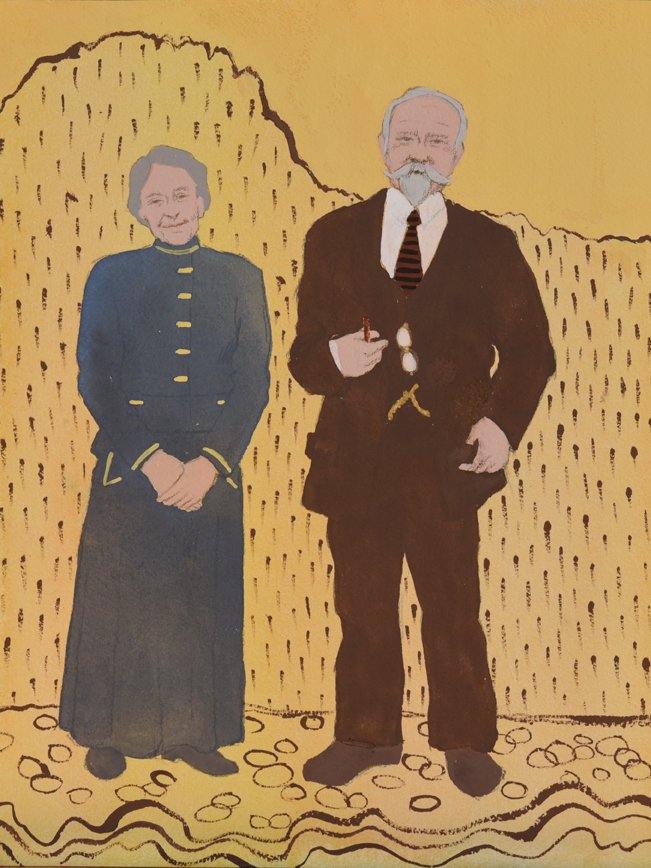
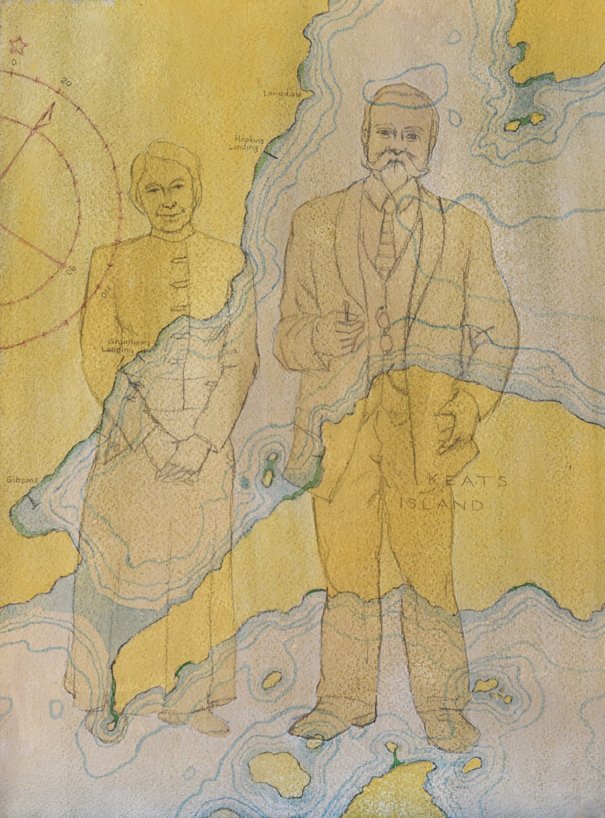

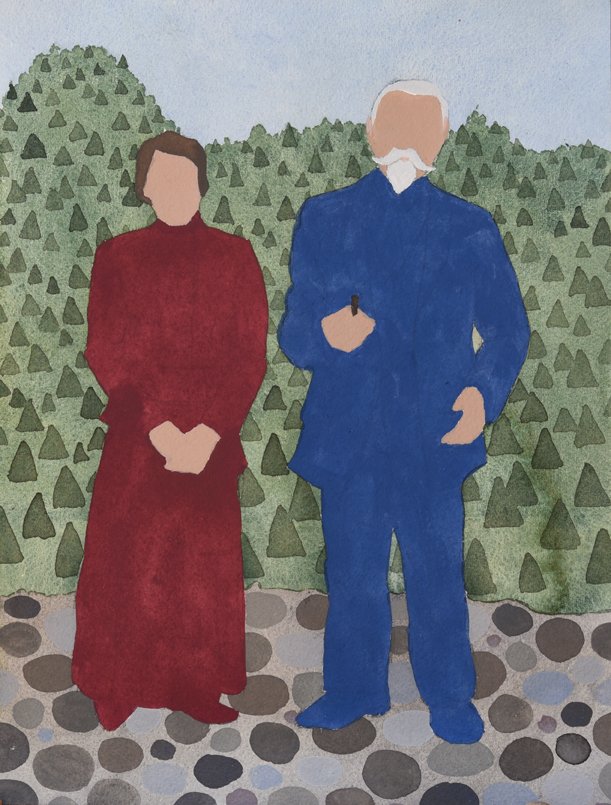

George Henderson Hopkins arrives in British Columbia in search of new beginnings and adventure. His wife Isa and their 4 children Gordon, Philip, Eustace and Grace follow. With whimsy, given the family’s UK origins, they ride in a tea cup and tea service. The style of art being inspired by the ‘Japonisme’ influence and the oriental blue and white china patterns that were so popular in the early 1900’s.


Grace was the youngest of GH and Isa Hopkins four children and their only daughter. Grace was born December 29, 1985 at Boundary House, Newport Monmouthshire Wales where the family lived. She was 11 when they moved to Hopkins Landing. As a young woman, Grace went on to work as a nurse at Vancouver General Hospital. She never married and sadly died at just 23 during the ‘Spanish flu’ epidemic in 1919.

Grace Henrietta Hopkins was the youngest of the four children of Isa and George H Hopkins, founder of Hopkins Landing. There was no actual road to get to the Howe Sound school in Gibsons which is several miles away so the family acquired a pony named ‘Bonnie’ for Grace to make her way there. The road from Gibsons Landing, through Granthams Landing to Hopkins Landing was not completed until 1912.
Sadly Grace died at just age 23 during the ‘Spanish flu’ epidemic working as a nurse.

I never had the chance to know my Grandmother Hopkins, having only met her when I was 2. Sadly she developed Parkinson’s and passed at age 76. Katherine Stuart had 6 siblings and was born in Erie, North Dakota. Her father John Matheson Stuart had ambitions to be a big rancher. He moved the family on to Weyburn, Saskatchewan for 8 years but the harsh winter drove the family as far west as they could go to Sooke BC. While living there, Katherine met the handsome Philip Hopkins who was working on a contract there on his family’s tug ‘Hopkins’ They fell in love and got married in Sooke and moved to Hopkins Landing. Katherine was musically gifted and played several instruments. She was particularly appreciated for her piano playing during community dances at the Hopkins Landing Hall in the 1930’s.

I never had the chance to know my Grandmother Hopkins, having only met her when I was 2. Sadly she developed Parkinsons and passed at age 76. Katherine Stuart had 6 siblings and was born in Erie, North Dakota. Her father John Matheson Stuart had ambitions to be a big rancher. He moved the family on to Weyburn, Saskatchewan for 8 years but the harsh winter drove the family as far west as they could go to Sooke BC. While living there, Katherine met the handsome Philip Hopkins who was working on a contract there on his family’s tug ‘Hopkins’ They fell in love and got married in Sooke and moved to Hopkins Landing. Katherine was musically gifted and played several instruments. She was particularly appreciated for her piano playing during community dances at the Hopkins Landing Hall in the 1930’s.

The former English armed escort vessel, HMS Finwhale, was brought back to Canada in 1922 by Gordon Hopkins where it was rechristened “Hopkins Bros.” It was refitted and hired to tow log barges, log booms and ships until 1927 when she was sold to the Canadian National Railway.

In 1909, construction began on a tugboat about 200 feet north of the wharf at Hopkins Landing. The SS Hopkins was the first tugboat of it’s size to be built in Howe Sound. The Hopkins family hired Arthur Moscrop, an experienced builder of boat hulls and brothers Gordon, Philip and Eustace worked alongside him. It took a couple of years to complete and the boat was launched and put into service in 1911. Duties for the able tug included being chartered for eleven years in Sooke to help with ‘brailing’ salmon from ‘cordon’ fish traps.

n 1909, construction began about 200 feet north of the wharf on the SS Hopkins, the first tugboat of it’s size to be built in Howe Sound. The Hopkins family hired Arthur Moscrop, an experienced builder of boat hulls and brothers Gordon, Philip and Eustace worked alongside him. It took a couple of years to complete and the boat was launched and put into service in 1911. Duties for the able tug included being chartered for eleven years in Sooke to help with ‘brailing’ salmon from ‘cordon’ fish traps.

Does friendship continue even after we are gone? My beloved Mother Joan and her friend since childhood, Jennifer, hauling sandbags together during the Red River flood in Winnipeg where they lived. It was a friendship that endured until Jennifer passed in 2011 just a couple of months before my Father’s passing. Life can be cruel. But such a friendship is a rare gift.

George Henderson Hopkins started work as an apprentice marine engineer at age 15. He went to sea at 20 and became a chief Engineer by 24 for the British India Steam Navigation Co. He returned to visit his brother in Wales where he stayed and ultimately became co-owner at Brittania Ironworks and a partner in Richards & Hopkins Manufacturing Engineers and Ship Repairers. He invented and patented a very successful machine to create coal briquettes. In his 52nd year his need for change and an adventurous spirit led him to seek new horizons and the appeal of British Columbia was very strong. He founded Hopkins Landing with his family in 1907 and lived there until 1931. While he was ‘retired’ he served as local Postmaster as well as being appointed a Justice of the Peace for British Columbia. George was 78 when he passed at the Landing. His legacy lives on.

My father and his love for the shape of boat hulls, standing here on a beach in England. Dad would often wander absorbed by his observations and my Mother Joan and I would have to chase him down. Dad was a very reflective man with a lot of observing going on. A few of his sketch books were on display at the show that gave viewers an idea of the mind behind the artist.

My grandfather EG Philip Hopkins looks to have been quite the dandy as a young man. Handsome in a Cary Grant way, he proudly paddles a canoe here at the Regatta in Hopkins Landing. Philip, second son of George and Isa Hopkins, was trained as a marine engineer worked with his brothers Gordon and Eustace on the family’s tugboats ‘Hopkins’ and ‘Hopkins Bros’. In WW1, he served with the Royal Flying Corps and Air Force in Egypt. After the war he worked on ships travelling between Vancouver and Japan. From 1941 to 1956 he lived in Vancouver and was employed as superintendent of ship repairs at Burrard Dry dock. He and wife Katherine returned to Hopkins landing in 1957/58 where they built a new home for their retirement years.

These contest winners, which includes my Father Don Hopkins and Virginia (McMillan) Young, were at the 1932 School Sports Days held at the YMCA camp property at Hopkins Landing. Events like this were important to the communities of the Sunshine Coast as they were relatively isolated from any major centres. Hopkins Landing, Grantham’s Landing and Gibsons took turns hosting the popular Howe Sound Regatta every summer. People from the city would boat in and camp to take part in some of the festivities.

My husband Rick and I were cycling along the river on Queensborough island and came across a large shipyard there with many boats of all shapes and sizes under repair. Being my father’s daughter, I liked looking at all the boat hull shapes and Rick is a sailor so he enjoyed it too. A large old tugboat was there propped up and she was in very bad shape. I felt an immediate connection to her historical presence. We returned on several occasions and I photographed and ran my hand along her mammoth wooden hull. I learned that she had been salvaged from the Gibsons’ harbour where she had sunk to the bottom. I don’t know much about her history other than in the final years she was being run as a floating b&b in Gibsons. Her age and majesty were a living connection for me to my family marine heritage. It made it visceral and that haunted me. The Reliant was disassembled, and scrapped shortly after my last visit in 2020. I felt fortunate and amazed I had the opportunity to see her before her demise. Serendipity at work.

My grandfather EGPhilip Hopkins and a lady friend glide through the calm waters off the Landing shore.

Katherine (Stuart) Hopkins and friend get off the steamship Comox at the Hopkins Landing wharf. The Comox was one of several steamships that connected and supplied the Landing and many other communities around Howe Sound. Other regular ships included the SS Belcarra, SS Britannia and occasionally the elegant Lady Patricia and stern wheeler Baramba.


The elegant Lady Patricia was an occasional visitor to Hopkins Landing. She was one of several steamships that connected and supplied the Landing and many other communities around Howe Sound. Regular ships included the SS Comox, SS Belcarra, SS Britannia and occasionally the stern wheeler Baramba.

This simple line drawing depicts sisters Grace (Hitchcock) and Nancy (Bown) Hopkins walking along the Hopkins Landing wharf during Regatta celebrations. Grace, Nancy and their sister Isabelle were daughters of Captain Gordon Scott Hopkins and his wife Catherine (Loutit) Hopkins.

Union steamships connected and supplied Hopkins Landing and many other communities around Howe Sound. Regular ships that docked at the Landing included the SS Comox, SS Belcarra, SS Britannia and occasionally the elegant Lady Patricia and stern wheeler Baramba.

From where my parents lived, the walk out to swim was very stoney with lots of barnacles compared with the other side of the wharf which is mostly sand and small pebbles. This made it challenging to walk and water shoes were essential to go swimming. It also meant there were less people walking the beach in front of their home which could be seen as a positive.

One of the great joys of living at Hopkins Landing is walking the beach. Residents walk their dogs, play with children and convene with neighbours, friends, relatives to catch up on news. I think they continue to walk the beach and ‘Hopkins Heritage Path’ even when gone from this world physically. The spirits are there having a lovely time together. (My father Don and his dog Sally in the foreground, his parents, my grandparents Philip and Katherine, Great Uncle Gordon, Great Aunt Grace, Great Uncle Eustace and others shown here...)

The view towards the mountains from my family’s home included these mysterious poles. I often wondered what they had been placed there for and what story they could tell…

Hopkins brothers Philip, Charles and Donald dream of great adventures at sea as they ready to race their model sail boats at the competition at Hopkins Landing c1938. They came by their interest in boats quite honestly as the Hopkins family have been great sailors for generations. Their father Philip and his brothers Gordon and T. Eustace built a wooden tugboat on the beach at Hopkins Landing and shared the business of running it together. A somewhat whimsical impression with ‘Japonisme’ influences (those famous Hokusai waves), the title harkens back to the tongue twister of my childhood that some of you may also recall.

One of many contests held at Annual Inter-school Sports Days held at the Y.M.C.A. camp at Hopkins Landing. People would come from the city in heat of the summer and set up tents to stay at the camp. The property was bought by Philip Hopkins in the 1950’s and a new house was built for he and wife Katherine to retire in. The ‘old bungalow’, the original structure from the camp days (shown in the painting) remained for many years and featured a large fireplace made with stones from the beach. It eventually became derelict and was taken down to make room for new property owners to build their homes.

Impression of the view from family property at Hopkins Landing towards Grace Island, Gambier island and the Coastal range mountains along Howe Sound.

People watch the various water events of the Annual Regatta from their rowboats .
“The Sunshine Coast didn’t have many permanent residents during the early 1900’s, but the summer months brought crowds of people looking to catch a break from the city, and with all these vacationers came the West Howe Sound Regatta. Starting in 1929, it was held alternately at Granthams Landing, Hopkins Landing, and Gibsons Landing. The wharves would be festively decorated with strings of paper lanterns, cedar boughs and flags. A “costume parade” started the festivities and soon enough the wharf would be brimming with spectators, many of whom had just made the trip over by a Union Steamship. The surrounding waters were swarming with local boats, there to participate in or simply watch the chaos. Events included homemade raft races, sailing races, swimming and diving competitions, and pillow fights in canoes. The regatta continued throughout the 30’s, but came to an end after the Second World War.” From Sunshine Coast Archives More recent generations of the community of Hopkins Landing continue the tradition in the form of Gala days with family swimming and boating races and the Annual Summer Picnic. In 2007 a celebration took place for the 100th Anniversary. Volunteers did a marvellous job and the dock was festooned in a fashion reminiscent of the older days. It’s wonderful that such a strong sense of community and heritage continues at Hopkins Landing!

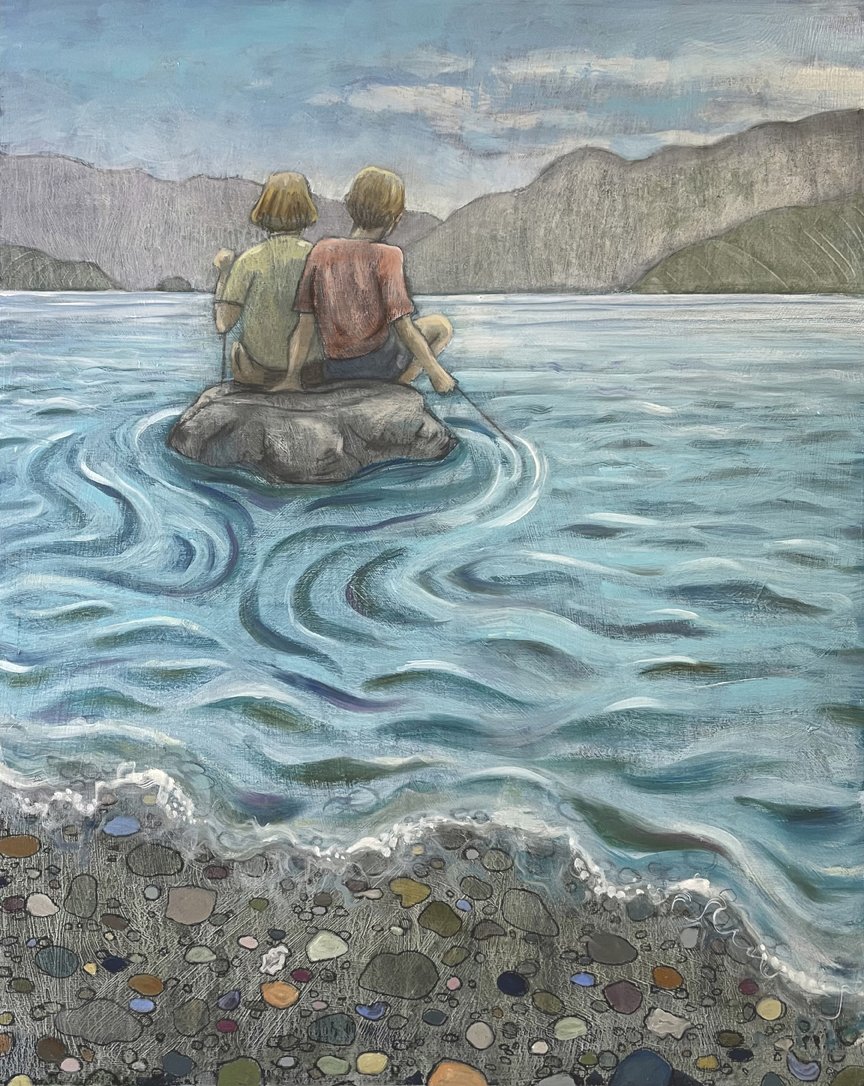
I have been very fortunate to be able to visit with my father’s cousin Nancy (Hopkins) Bown in her Hopkins Landing home. She and Dad played together as children growing up at the Landing. One of my favourite tales she told me was how they used to sit together on a big rock on the beach and watch the tide slowly come in. Such a contrast with today’s life of overloaded senses and technological relationships. It gives me peace just thinking about them sitting there together.

Philip Hopkins was my father’s oldest brother. I remember Uncle Phil as a gentle soul. He served in the second World War in HMS Navy on an Atlantic convoy mine sweeping for the Normandy Invasion. He contracted Tuberculosis during the war and returned from duty as an invalid with greatly compromised lung capacity. He met and fell in love with Mary Devine, a nurse working the hospital he where he was convalescing. He and my Aunt Brownie (Mary) lived in North Vancouver before retiring to Hopkins Landing. My Aunt took very good care of my uncle and managed to raise 4 children as well! While my uncle’s disease left his capacity limited, he was quite creative (something shared by the brothers) and inventive working on ink drawings, linocut prints and beautiful instruments like his mandolin ‘Lola’. I remember Uncle Phil had a surprisingly mischievous sense of humour. While visiting the family in North Van as a young teen, he exclaimed at the dinner table ‘OH NO’ and held up what appeared to be a bloody finger stump on his hand. Phil had lost the tip in the war and had spread ketchup on the end. He was only 57 years old when he passed.
John Philip Hopkins Jul 2 1921 - April 7 1979 Mary Irene (Divine) Hopkins Oct 16 1923 - Nov 25 2004. I am very grateful for my cousins Paul, Peter, Sheila and Eric

After the sale of the “SS Hopkins’ in 1921, the family decided to find and purchase a ship that could be used as a passenger vessel with a possibility of contract subsidy to handle the mail run for west Howe Sound. Brothers Gordon and Philip travelled to Southhampton England where they purchased the former armed escort vessel, HMS Finwhale. She was an impressive ship, steel hulled and 135 feet long. Refitting and seaworthy preparations were undertaken at the shipyards and the boat was rechristened the“Hopkins Bros”. Philip returned to BC and according to my great Uncle Gordon, what happened as he began the voyage back to Canada “was like a nightmare - the hardships, discomforts, and frustrations were as bad as anything that I had experienced in either France, Belgium, Persia or in Baku, Russia during World War 1’ and “we never dreamed it would be a year before we arrived back home” (Hopkins Landing). He recounts the first crew were Canadians and “looked like a bunch of jail-birds” A few days after the voyage began, the ship was taking on saltwater in the boiler and life boats were readied in case of the need to abandon ship. After rolling violently in the Atlantic seas the leak was plugged temporarily and they limped with ongoing troubles to the Azores for more reparations. Gordon mentions his diary read “THIS IS HELL” ! While there the crew “a most incompetent lot” started drinking and fighting and beat up the skipper who opened fire on them in defence. They were jailed by local police and shipped back to England. After repairs were completed and a new crew was taken on the ship sailed for Vancouver arriving October 6 1922. Gordon had been away 13 months and his first child Grace was only two days old when he had left. The opportunity to operate as a passenger ship was now past so Gordon, Philip and Eustace converted the ship to a deep sea tug. The “Hopkins Bros” would be hired to tow log barges, log booms and ships until 1927 when she was sold to the Canadian National Railway.
An exhibition of works that paid tribute to Hopkins Landing family history and the close connection between father and daughter artists. How do we keep meaningful connections alive when physical relationships are lost? Gibsons Public Art Gallery, JULY 13th- 30th, 2023.
All works are for sale unless marked SOLD or NFS. Please inquire via email (Contact page)



















































